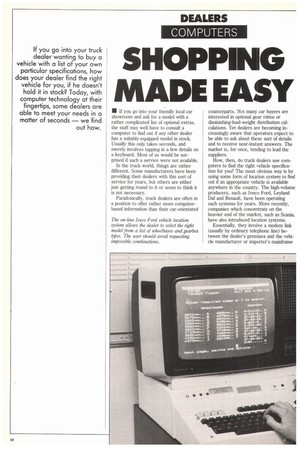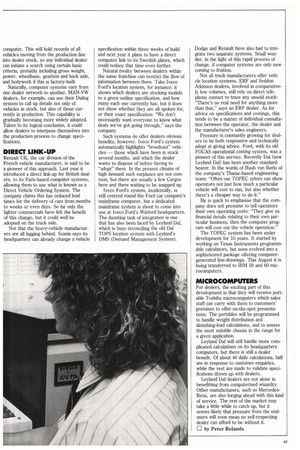SHOPPING MADE EASY
Page 42

Page 43

Page 44

If you've noticed an error in this article please click here to report it so we can fix it.
• If you go into your friendly local car showroom and ask for a model with a rather complicated list of optional extras, the staff may well have to consult a computer to find out if any other dealer has a suitably-equipped model in stock. Usually this only takes seconds, and merely involves tapping in a few details on a keyboard. Most of us would be surprised if such a service were not available.
In the truck world, things are rather different. Some manufacturers have been providing their dealers with this sort of service for years, but others are either just getting round to it or seem to think it is not necessary.
Paradoxically, truck dealers are often in a position to offer rather more computerbased information than their car-orientated The on-line 1 veco Ford vehicle location system allows the dealer to select the right model from a list of wheelbases and gearbox types. The user should avoid requesting impossible combinations. counterparts. Not many car buyers are interested in optional gear ratios or diminishing-load-weight distribution calculations. Yet dealers are becoming increasingly aware that operators expect to be able to ask about these sort of details and to receive near-instant answers. The market is, for once, tending to lead the suppliers.
How, then, do truck dealers use computers to find the right vehicle specification for you? The most obvious way is by using some form of location system to find out if an appropriate vehicle is available anywhere in the country. The high-volume producers, such as lveco Ford, Leyland Daf and Renault, have been operating such systems for years. More recently, companies which concentrate on the heavier end of the market, such as Scania, have also introduced location systems.
Essentially, they involve a modem link (usually by ordinary telephone line) between the dealer's premises and the vehicle manufacturer or importer's mainframe computer. This will hold records of all vehicles moving from the production line into dealer stock, so any individual dealer can initiate a search using certain basic criteria, probably including gross weight, power, wheelbase, gearbox and back axle, and bodywork if this is factory-built.
Naturally, computer systems vary from one dealer network to another. MAN-VW dealers, for example, can use their Dialog system to call up details not only of vehicles in stock, but also of those currently in production. This capability is gradually becoming more widely adopted. Taken to its logical conclusion, it could allow dealers to interpose themselves into the production process to change specifications.
DIRECT LINK-UP
Renault UK, the car division of the French vehicle manufacturer, is said to be a pioneer of this approach. Last year it introduced a direct link-up for British dealers, to its Paris-based computer systems, allowing them to use what is known as a Direct Vehicle Ordering System. The company claims this has reduced lead times for the delivery of cars from months to weeks or even days. So far only the lighter commercials have felt the benefit of this change, but it could well be adopted on the truck side.
Not that the heavy-vehicle manufacturers are all lagging behind. Scania says its headquarters can already change a vehicle specification within three weeks of build and next year it plans to have a direct computer link to its Swedish plants, which could reduce that time even further.
Natural rivalry between dealers within the same franchise can restrict the flow of information between them. Take Iveco Ford's location system, for instance: it shows which dealers are stocking models to a given outline specification, and how many each one currently has; but it does not show whether they are all spoken for, or their exact specification: "We don't necessarily want everyone to know what deals we've got going through," says the company.
Such systems do offer dealers obvious benefits, however. Iveco Ford's system automatieally highlights "broadcast" vehicles — those which have been in stock several months, and which the dealer wants to dispose of before having to "adopt" them. In the present climate of high demand such surpluses are not common, but there are usually a few Cargos here and there waiting to be snapped up.
Iveco Ford's system, incidentally, is still centred round the Ford car company's mainframe computer, but a dedicated mainframe system is about to come into use at Iveco Ford's Watford headquarters. The daunting task of integration is one that has also been faced by Leyland Daf, which is busy reconciling the old Daf TOPS location system with Leyland's DMS (Demand Management System). Dodge and Renault have also had to integrate two separate systems. Small wonder, in the light of this rapid process of change, if computer systems are only now coming to fruition.
Not all truck manufacturers offer vehicle location systems. ERF and Seddon Atkinson dealers, involved in comparatively low volumes, still rely on direct telephone contact to trace any unsold stock: "There's no real need for anything more than that," says an ERF dealer. As for advice on specifications and costings, this tends to be a matter of individual consultation between the operator, the dealer and the manufacturer's sales engineers.
Pressure is constantly growing for dealers to be both responsive and technically adept at giving advice. Ford, with its old FOCAS operational costing system, was a pioneer of this service. Recently Daf (now Leyland Daf) has been another standardbearer. in the words of Huub van Berk) of the company's Thame-based engineering team: "Often our TOPEC sytem can show operators not just how much a particular vehicle will cost to run, but also whether there's a cheaper way to do it."
He is quick to emphasise that the company does not presume to tell operators their own operating costs: `They give us financial details relating to their own particular business, then the computer program will cost out the vehicle operation."
The TOPEC system has been under development for 10 years. It started by working on Texas Instruments programmable calculators, but soon evolved into a sophisticated package offering computergenerated line-drawings. This August it is being transferred to IBM 50 and 60 microcomputers.
MICROCOMPUTERS
For dealers, the exciting part of this development is that they will receive portable Toshiba microcomputers which sales staff can carry with them to customers' premises to offer on-the-spot presentations. The portables will be programmed to handle weight distribution and dimishing-load calculations, and to assess the most suitable chassis in the range for a given application.
Leyland Daf will still handle more complicated calculations on its headquarters computers, but there is still a dealer benefit. Of about 40 daily calculations, half are in response to customer enquiries, while the rest are made to validate specifications drawn up with dealers.
Leyland Daf dealers are not alone in benefitting from computerised wizardry. Other manufacturers, such as MercedesBenz, are also forging ahead with this kind of service. The rest of the market may take a little while to catch up, but it seems likely that pressure from the endusers will soon mean no self-respecting dealer can afford to be without it. El by Peter Rolands
'Air suspension is set to replace the mechanical set-up as the nation's most popular suspension over the next few years: That's not Mercedes talking. 'Truck' magazine said that, way back in December 1987. And it's no sweeping statement.
A look at the trailer market alone shows why. Two years ago, only 5% of 3-axle trailers were built with air suspension. Today, over 300/a have it. Increasingly, the benefits are being recognised by operators and customers alike.
Particularly those who transport brittle foodstuffs like crisps and other fragile loads.
For such people, the attractions are obvious.
LESS TURBULENCE By AIR
The chief buyer at a large bottling plant recently told journalists how he could spot which bottles had arrived on air suspension: they had fewer scratches from rubbing against each other,








































































